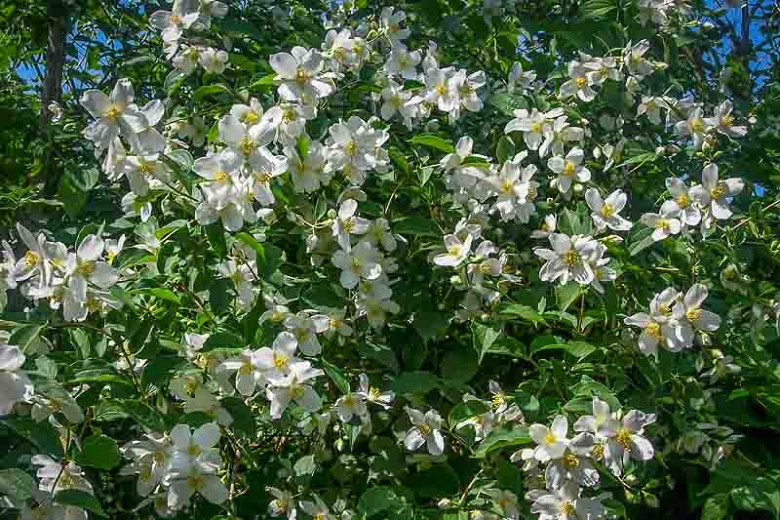How To Grow Lewis Mock Orange For A Fragrant Garden
Title: How to Grow Lewis Mock Orange for a Fragrant Garden
Introduction:
Lewis mock orange (Philadelphus lewisii) is a beautiful and fragrant shrub that is native to western North America. It is known for its white flowers, which bloom in the spring and early summer. Lewis mock orange is a relatively easy plant to grow, and it is a great addition to any garden.
In this blog post, we will discuss how to grow Lewis mock orange. We will cover topics such as choosing the right location, planting, watering, fertilizing, and pruning. We will also provide some tips on how to attract butterflies and other pollinators to your Lewis mock orange bush.
Main Content:
Choosing the Right Location
Lewis mock orange prefers full sun or partial shade. It can tolerate a wide range of soil conditions, but it does best in moist, well-drained soil. The ideal pH for Lewis mock orange is between 6.0 and 7.0.
Planting
Lewis mock orange can be planted in the spring or fall. When planting, dig a hole that is twice as wide and as deep as the root ball. Backfill the hole with soil, tamp it down, and water well.
Watering
Lewis mock orange needs regular watering, especially during the first year after planting. Once the plant is established, it is more drought tolerant. However, it is still a good idea to water during periods of dry weather.
Fertilizing
Lewis mock orange does not need to be fertilized heavily. A light application of fertilizer in the spring will help the plant to bloom well. A balanced fertilizer, such as 10-10-10, is a good choice.
Pruning
Lewis mock orange should be pruned after flowering. This will help to keep the plant in shape and encourage new growth. Prune the branches back by one-third to one-half.
Attracting Butterflies and Pollinators
Lewis mock orange is a magnet for butterflies and other pollinators. To attract even more of these beneficial insects, plant Lewis mock orange near other flowering plants that bloom at the same time. Some good companion plants for Lewis mock orange include:
- Butterfly bush
- Lavender
- Coneflower
- Bee balm
- Zinnia
Conclusion
Lewis mock orange is a beautiful and fragrant shrub that is easy to grow. With a little care, you can enjoy its sweet scent for many years to come.
If you are interested in learning more about Lewis's mock orange, I recommend visiting Home Gardening. This website has a wealth of information about the plant, including its history, cultivation, and uses. You can also find photos and videos of the plant, as well as a forum where you can ask questions and connect with other Lewis's mock orange enthusiasts.
FAQ of lewis mock orange
Frequently Asked Questions about Lewis Mock Orange
- What is Lewis mock orange?
Lewis mock orange (Philadelphus lewisii) is a deciduous shrub native to the western United States. It is known for its fragrant white flowers, which bloom in late spring or early summer. Lewis mock orange is a hardy plant that can tolerate a wide range of conditions, making it a popular choice for landscaping.
- What are the benefits of growing Lewis mock orange?
In addition to its attractive flowers, Lewis mock orange has a number of other benefits. It is a low-maintenance plant that is drought-tolerant and deer-resistant. Lewis mock orange can also help to attract pollinators to your garden.
- How to care for Lewis mock orange?
Lewis mock orange is a relatively easy plant to care for. It prefers full sun to partial shade and well-drained soil. Water Lewis mock orange regularly during the growing season, but allow the soil to dry out between waterings. Fertilize Lewis mock orange in the spring with a balanced fertilizer.
- How to propagate Lewis mock orange?
Lewis mock orange can be propagated by seed, cuttings, or division. Seed propagation is the least successful method, but it can be done by sowing seeds in the fall or spring. Cutting propagation is the most successful method. Take cuttings in the spring or summer and root them in a mixture of sand and peat moss. Division is another successful method. Divide Lewis mock orange in the spring or fall.
- What are the common problems with Lewis mock orange?
The most common problem with Lewis mock orange is powdery mildew. Powdery mildew can be treated with a fungicide. Other problems with Lewis mock orange include aphids, scale, and spider mites. These pests can be controlled with insecticidal soap or neem oil.
Image of lewis mock orange
- Lewis' mock-orange also syringa (in german Oregon Pfeifenstrauch) Philadelphus lewisii

- A close-up of the white flowers of Lewis' mock orange

- A cluster of Lewis' mock orange flowers in bloom

- A full-grown Lewis' mock orange shrub

- The leaves of Lewis' mock orange, which are green in the summer and turn yellow in the fall

- The bark of Lewis' mock orange, which is smooth and gray
- A hummingbird feeding on the nectar of a Lewis' mock orange flower
- A bee pollinating a Lewis' mock orange flower

- A butterfly nectaring on a Lewis' mock orange flower

- A field of Lewis' mock orange shrubs in bloom

Post a Comment for "How To Grow Lewis Mock Orange For A Fragrant Garden"